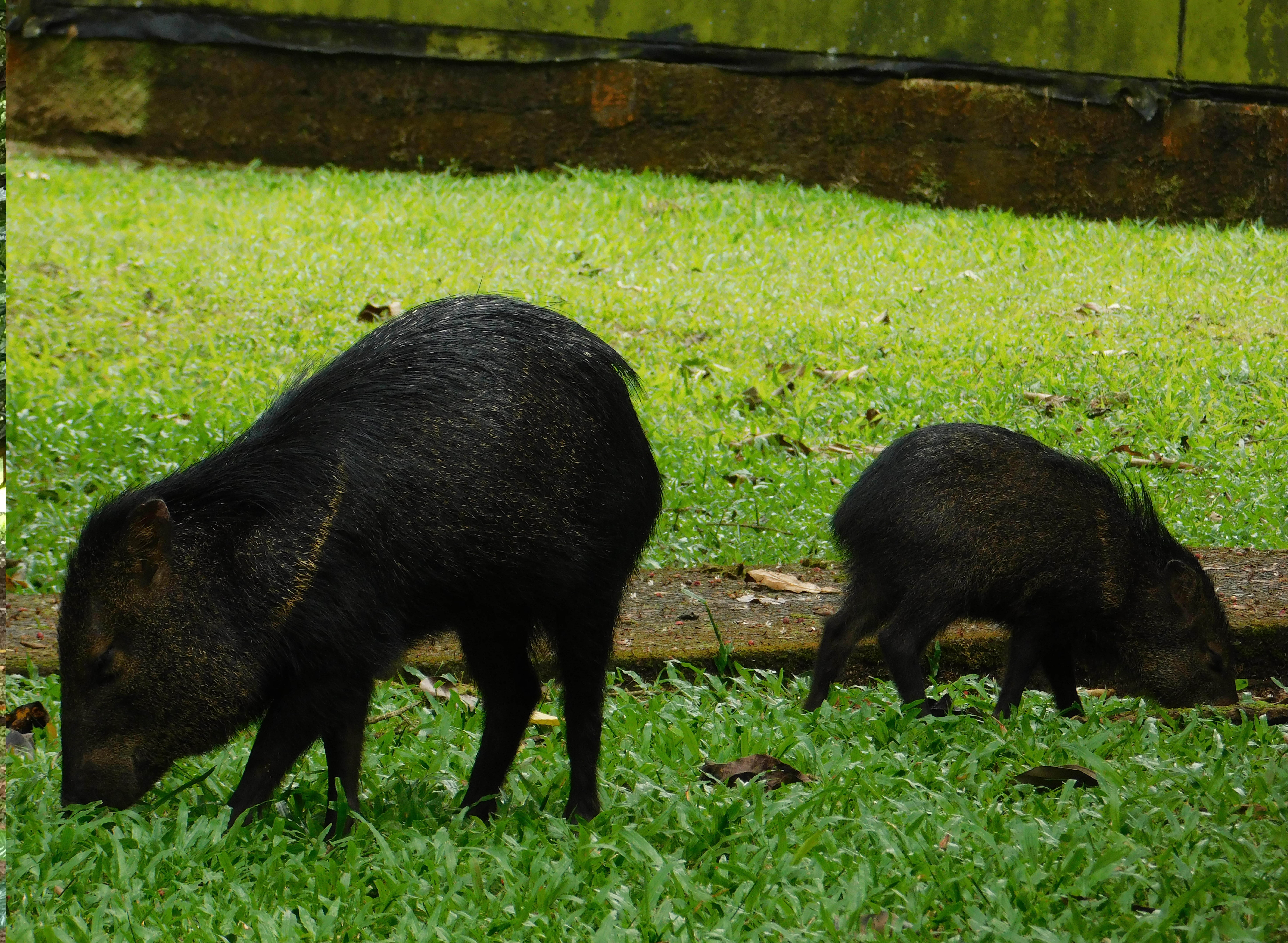Resumen
El objetivo de esta investigación fue analizar el uso de espacios naturales y antropizados por el pecarí de collar (Dicotyles tajacu) en la Estación Biológica La Selva (EBLS), Costa Rica. Se registraron grupos e individuos de pecaríes mediante observaciones directas e indirectas, contando un total 170 individuos adultos y 30 crías (media = 3.62, DS = 4.04). El uso del espacio a nivel de sitio difirió del uso esperado (p < 0.000, X2 observado = 134.14, X2 acumulado = 22.36). La prueba de bondad de ajuste de chi-cuadrado mostró una fuerte evidencia de que no existe un uso proporcional con el área de las categorías (X2 = 832.30, df = 10, n = 76, P > 0.0001). Los intervalos de confianza de Bonferroni (IC 95%) evidenciaron mayor proporción de uso observado con respecto al esperado para las categorías agroforestería abandonada y área con infraestructura. Estas áreas son manejadas por la administración de la EBLS y existen árboles frutales, huertos, construcciones y mayor intensidad de uso público, por lo que para los pecaríes representan zonas de alimentación, refugio y descanso.
Citas
Agrawal, A. A., D.D., Ackerly, F. Adler, A.E. Arnold, C. Cáceres, D.F. Doak, E. Post, P.J. Hudson, J. Maron, K.A. Mooney, M. Power, D. Schemske, J. Stachowicz, S. Strauss, M.G. Turner y E. Werner. 2007. Filling key gaps in population and community ecology. Frontiers in Ecology and the Enviroment, 5:145–152. https://doi.org/10.1890/1540-9295
Alldredge, J. R. y J. Griswold. 2006. Design and analysis of resource selection studies for categorical resource variables. Journal of Wildlife Management, 70:337–346. https://www.jstor.org/stable/3803679
Armstrong, A. H., A. Huth, B. Osmanoglu, G. Sun, K.J. Ranson y R. Fischer. 2020. A multi-scaled analysis of forest structure using individual-based modeling in a Costa Rican rainforest. Ecological Modelling, 433: 109226. https://doi.org/10.1016/J.ECOLMODEL.2020.109226
Arroyo-Arce, S., L. Berrondo, Y. Canto, N. Carrillo, V.G. Carrillo, C. Loaiza, M. Méndez, D. Rivera y K. Unda. 2013. Uso de dos tipos de bosque por saínos (Pecari tajacu) en estación “la selva”, Costa Rica. Cultura Científica, 0:32–39. http://www.revistasjdc.com/main/index.php/ccient/article/view/215
Beck, H. 2005. Seed predation and dispersal by peccaries throughout the neotropics and its consequences: a review and synthesis. Pp. 77–115, en: Seed fate: predation, dispersal and seedling establishment. (Forget, P.M., Lambert, J.E., Hulme, P.E., y S. B. Vander Wall, eds.). CABI Publishing. Wallingford, United Kingdom.
Beck, H. 2007. Synergistic impacts of ungulates and falling palm fronds on saplings in the Amazon. Journal of Tropical Ecology, 23:599–602.
Bellantoni, E. S. y P.R. Krausman. 1993. Habitat Use by collared peccaries in an urban environment. The Southwestern Naturalist, 38:345-351. https://doi.org/10.2307/3671613
BiotasTM. 2004. Version 2.0a Help and manual. Ecological Software Solutions LLC. https://www.ecostats.com/Biotas
Briceño-Méndez, M., E. Naranjo, M. Altrichter y S. Mandujano. 2017. Availability of two species of fruits and their influence on the social structure of Tayassu pecari and Dicotyles tajacu. Therya, 8:193–198. http://132.248.10.25/therya/index.php/THERYA/article/view/450/pdf_175
Byers, J. A. y M. Bekoff. 1981. Social, spacing, and cooperative behavior of the collared peccary, Tayassu tajacu. Journal of Mammalogy, 62:767–785. https://doi.org/10.2307/1380598
Carrillo, E., G. Wong y J.C. Sáenz. 1999. Mamíferos de Costa Rica. Instituto Nacional de Biodiversidad, Costa Rica.
Clark, D. A., D.B. Clark y S.F. Oberbauer. 2013. Field-quantified responses of tropical rainforest aboveground productivity to increasing CO2 and climatic stress, 1997–2009. Journal of Geophysical Research: Biogeosciences, 118:783–794. https://doi.org/10.1002/JGRG.20067
Clark, D. B., y D.A. Clark. 1989. The Role of Physical Damage in the Seedling Mortality Regime of a Neotropical Rain Forest. Oikos, 55:225-230.
Cromsigt, J. P. G. M., H.H.T. Prins y H. Olff. 2009. Habitat heterogeneity as a driver of ungulate diversity and distribution patterns: interaction of body mass and digestive strategy. Diversity and Distributions, 15:513–522. https://doi.org/10.1111/J.1472-4642.2008.00554.X
de Cassia Bianchi, R., R. Calixto-Campos, N.L. Xavier-Filho, N. Olifiers, M.E. Gompper y G. Mourão. 2013. Intraspecific, interspecific, and seasonal differences in the diet of three mid-sized carnivores in a large neotropical wetland. Acta Theriologica , 59:13–23. https://doi.org/10.1007/S13364-013-0137-X
de Cassia Bianchi, R., y S.L. Mendes. 2007. Ocelot (Leopardus pardalis) predation on primates in Caratinga Biological Station, Southeast Brazil. American Journal of Primatology, 69:1173–1178. https://doi.org/10.1002/AJP.20415
de Cassia Bianchi, R., S.L. Mendes y P. de Marco Júnior. 2010. Food habits of the ocelot, Leopardus pardalis, in two areas in southeast Brazil. Studies on Neotropical Fauna and Enviroment, 45:111–119. https://doi.org/10.1080/01650521.2010.514791
Delibes, M., J. Calzada, C. Chávez, E. Revilla, B.A. Ribeiro, D. Prado, C. Keller y F. Palomares. 2011. Unusual observation of an ocelot (Leopardus pardalis) eating an adult Linnaeus’s two-toed sloth (Choloepus didactylus). Mammalian Biology, 76:240–241. https://doi.org/10.1016/J.MAMBIO.2010.08.006
Ellisor, J. E. y W.F. Harwell. 1969. Mobility and home range of collared peccary in Southern Texas. The Journal of Wildlife Management, 33:425-427. https://doi.org/10.2307/3799848
Falconi-Briones, F. A., E.J. Naranjo, R. Reyna-Hurtado, M. Spínola, P. Enríquez-Rocha y R.A. Medellín, R. 2022. Habitat use and activity patterns of ungulates in a tropical rainforest of southern México. Therya, 13:171–182. https://doi.org/10.12933/THERYA-22-1167
Ferreguetti, A. C., C.L. Davis, W.M. Tomas y H.G. Bergallo. 2018. Using activity and occupancy to evaluate niche partitioning: the case of two peccary species in the Atlantic Rainforest, Brazil. Hystrix, the Italian Journal of Mammalogy, 29:168–174. https://doi.org/10.4404/HYSTRIX-00068-2018
Fragoso, J. M. 1999. Perception of scale and resource partitioning by peccaries: behavioral causes and ecological implications. Journal of Mammalogy, 80:993–1003. https://doi.org/10.2307/1383270
Green, M. C., L.A. Harveson y L.E. Loomis. 2001. Habitat selection by collared peccaries in trans-pecos Texas. Southwestern Naturalist, 46:246–251. https://doi.org/10.2307/3672541
Hartshorn, G. S. 1983. Plants. Pp. 118–157, en: Costa Rican Natural History (D. Janzen, ed.).
Jolochin, G. 2014. Patrones de nerviación foliar en Myrtaceae de la Estación Biológica La Selva, provincia de Heredia, Costa Rica. Polibotanica, 38:95–111. http://sura.ots.ac.cr/local/
Jones, P. F., A.F. Jakes, A.C. Telander, H. Sawyer, B.H. Martin y M. Hebblewhite. 2019. Fences reduce habitat for a partially migratory ungulate in the Northern Sagebrush Steppe. Ecosphere, 10:e02782. https://doi.org/10.1002/ECS2.2782
Keuroghlian, A. y D.P. Eaton, D. P. 2008. Fruit Availability and Peccary Frugivory in an Isolated Atlantic Forest Fragment: Effects on Peccary Ranging Behavior and Habitat Use. Biotropica, 40:62–70. https://doi.org/10.1111/J.1744-7429.2007.00351.X
Keuroghlian, A., D.P. Eaton y W.S. Longland. 2004. Area use by white-lipped and collared peccaries (Tayassu pecari and Tayassu tajacu) in a tropical forest fragment. Biological Conservation, 120:411–425. https://doi.org/10.1016/J.BIOCON.2004.03.016
Kuprewicz, E. K. 2013. Mammal abundances and seed traits control the seed dispersal and predation roles of terrestrial mammals in a Costa Rican Forest. Biotropica, 45:333–342. https://doi.org/10.1111/BTP.12014
Latham, S. R., A.P.K. Sirén y L.R. Reitsma. 2023. Space use and resource selection of Wood Turtles (Glyptemys insculpta) in the northeastern part of its range. Canadian Journal of Zoology, 101:20–31. https://doi.org/10.1139/CJZ-2022-0052
Martínez-Gutiérrez, P. G., E. Martínez-Meyer, F. Palomares y N. Fernández. 2017. Niche centrality and human influence predict rangewide variation in population abundance of a widespread mammal: The collared peccary (Pecari tajacu). Diversity and Distributions, 24:103–115. https://doi.org/10.1111/DDI.12662
Mcclearn, D., J.P. Arroyo-Mora, E. Castro, R.C. Coleman, J.F. Espeleta, C. García-Robledo, A. Gilman, J. González, A.T. Joyce, E. Kuprewicz, J.T. Longino, N. Michel, C.M. Rodríguez, A. Romero, C. Soto, O. Vargas, A. Wendt, S. Whitfield y R.M. Timm. 2016. The caribbean lowland evergreen moist and wet forests. Pp. 527–587, en: Costa Rica ecosystems. (M. Kepelle, ed.). University of Chicago Press.
Méndez-Figueroa, M. 2014. Densidad, relación con la vegetación, daños a cultivos agrícolas e interacción humanos-saínos (Pecari tajacu) en la Estación Biológica y fincas aledañas. Tesis de maestría, Instituto Internacional de Conservación y Manejo de Vida Silvestre, Universidad Nacional.
Michel, N. L., T.W. Sherry y W.P. Carson. 2014. The omnivorous collared peccary negates an insectivore-generated trophic cascade in Costa Rican wet tropical forest understorey. Journal of Tropical Ecology, 30:1–11. https://doi.org/10.1017/S0266467413000709
Murray, J. L. y G.L. Gardner. 1997. Leopardus pardalis. Mammalian Species, 548:1–10. https://doi.org/10.2307/3504082/2600738
Naughton-Treves, L.., J.L. Mena, A. Treves, N. Alvarez y V.C. Radeloff. 2003. Wildlife survival beyond park boundaries: the Impact of slash-and-burn agriculture and hunting on mammals in Tambopata, Peru. Conservation Biology, 17:1106–1117. https://doi.org/10.1046/J.1523-1739.2003.02045.X
Neu, C. W., C.R. Byers y J.M. Peek. 1974. A technique for analysis of utilization-availability data. The Journal of Wildlife Management, 38:541-545. https://doi.org/10.2307/3800887
O’Brien, C. S., H.M. Boyd, P.R. Krausman, W.B. Ballard, S.C. Cunningham y J.C. de Vos. 2005. Influence of wildfire and coyote presence on habitat use by collared peccaries. Wildlife Society Bulletin, 33:865–875. https://doi.org/10.2193/0091-7648(2005)33
Ontiveros, T. Y., F.M. Cappa, C.M. Campos y S.M. Giannoni. 2021. Confirmación de la presencia de pecarí de collar (Pecari tajacu) en el Parque Provincial Ischigualasto (San Juan, República Argentina). Notas Sobre Mamíferos Sudamericanos, 01:001–006. https://doi.org/10.31687/SAREMNMS.2020.0.10
Oviedo- Pérez, P. 2008. Distribución espacial de tinámidos (TINAMIFORMES) en la Estación Biológica La Selva, Costa Rica. Uniciencia, 22:93–97. https://www.redalyc.org/articulo.oa?id=475948929011
Paine, C. E. T. y H. Beck. 2007. Seed predation by neotropical rain forest mammals increases diversity in seedling recruitment. Ecology, 88:3076–3087.
Raich, J. W., D.A. Clark, L. Schwendenmann y T.E. Wood. 2014. Aboveground tree growth varies with belowground carbon allocation in a tropical rainforest environment. PLOS ONE, 9:e100275. https://doi.org/10.1371/JOURNAL.PONE.0100275
Redfern, J. V., R. Grant, H. Biggs y W. M. Getz. 2003. Surface-Water constraints on herbivore foraging in the Kruger National Park, South Africa. Ecology, 84:2092–2107. https://doi.org/10.1890/01-0625
Regolin, A. L., L.G. Oliveira-Santos, M.C. Ribeiro y L.L. Bailey. 2021. Habitat quality, not habitat amount, drives mammalian habitat use in the Brazilian Pantanal. Landscape Ecology, 36:2519–2533. https://doi.org/10.1007/S10980-021-01280-0/FIGURES/4
Reyna-Hurtado, R., I. March, E. Naranjo y S. Mandujano. 2014. Pecaríes en México. Pp. 339–362, en: Ecología y manejo de fauna silvestre en México. (Valdez, R., y J.A. Ortega, eds.). Colegio de Postgraduados and New Mexico State University.
Reyna-Hurtado, R. y G.W. Tanner. 2005. Habitat preferences of ungulates in hunted and nonhunted areas in the Calakmul Forest, Campeche, Mexico. Biotropica, 37:676–685. https://doi.org/10.1111/J.1744-7429.2005.00086.X
Robinson, C., S. Saatchi, D. Clark, J.H. Astaiza, A.F. Hubel y T.W. Gillespie. 2018. Topography and three-dimensional structure can estimate tree diversity along a tropical elevational gradient in Costa Rica. Remote Sensing, 10:629. https://doi.org/10.3390/RS10040629
Roldán, A. I. y J.A. Simonetti. 2001. Plant-Mammal Interactions in Tropical Bolivian Forests with Different Hunting Pressures. Conservation Biology, 15:617–623.
Romero, A., B.J. O’Neill, R.M. Timm, K.G. Gerow y D. McClearn. 2013. Group dynamics, behavior, and current and historical abundance of peccaries in Costa Rica’s Caribbean lowlands. Journal of Mammalogy, 94:771–791. https://doi.org/10.1644/12-MAMM-A-266.1/2/JMAMMAL-94-4-771-FIG5.JPEG
Sowls, L. 1997. Javelinas and other peccaries: their biology, management, and use. 2da. ed., University Press, Texas, EE.UU. https://www.tamupress.com/9781623490089/javelinas-and-other-peccaries
Sunquist, M., y F. Sunquist. 2002. Wild cats of the world. University of Chicago Press, Chicago, and London
Tejeda-Cruz, C., E.J. Naranjo, A.D. Cuarón, H. Perales y J.L. Cruz-Burguete. 2009. Habitat use of wild ungulates in fragmented landscapes of the Lacandon Forest, Southern Mexico. Mammalia, 73:211–219. https://doi.org/10.1515/MAMM.2009.044/MACHINEREADABLECITATION/RIS
Torrealba-Suárez, I. M. 1993. Ecología de los Grupos de sainos (Tayassu tajacu) y daños que ocasionan en los cultivos vecinos a La Estación Biológica La Selva, Costa Rica. Tesis de maestría, Instituto Internacional de Conservación y Manejo de Vida Silvestre, Universidad Nacional.

Esta obra está bajo una licencia internacional Creative Commons Atribución-NoComercial-SinDerivadas 4.0.
Derechos de autor 2023 UNIVERSIDAD NACIONAL AUTÓNOMA DE MÉXICO




